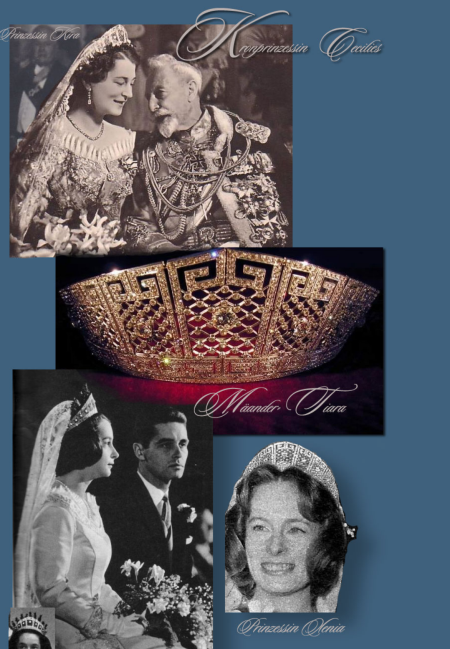
From hidden Treasures & History of Royal Jewels | The story of the:
The renowned German jeweler Koch was established in 1879 by the brothers Robert (1852-1902) and Louis Koch (1862-1930). The Koch brothers quickly distinguished themselves for exceptional quality in both design and craftsmanship, rooted in the rich goldsmithing traditions of Hanau. Their workshop collaborated with the esteemed Hanauer Bijouteriefabrik Friedrich Kreuter & Co., which played a crucial role in the manufacturing of their high-quality pieces. Koch’s main store was located in Frankfurt, and they later opened a boutique in Baden-Baden, one of Germany’s most fashionable spa destinations of the era.
Koch’s exceptional designs soon attracted the attention of Germany’s high nobility, including the German Imperial family, particularly during the Belle Époque. Their refined creations, known for both elegance and exquisite detail, became highly sought after by royalty. One notable commission was a delicate neoclassical diamond tiara crafted for Princess Victoria Luise, the daughter of Emperor Wilhelm II, epitomizing the sophistication and artisanal skill that defined Koch’s legacy.
Koch and Kreuter’s collaboration represents a fascinating chapter in German jewelry history, merging artistic vision with masterful craftsmanship. While Koch, with his impeccable taste and understanding of aristocratic elegance, became a jeweler to Germany’s elite, Friedrich Kreuter’s workshop brought the designs to life with unmatched skill and precision. The Hanauer Bijouteriefabrik Friedrich Kreuter & Co., established as one of Hanau’s premier jewelry manufacturers, was celebrated for its attention to detail and ability to produce intricate, high-quality pieces that aligned perfectly with Koch’s sophisticated aesthetics.
Throughout the Belle Époque, Koch and Kreuter produced many remarkable pieces that went beyond simple adornment, becoming symbols of status, heritage, and artistry. Their works ranged from tiaras and parures set with diamonds and colored gemstones to unique neoclassical creations with delicate, often floral motifs that reflected the era’s fascination with natural forms. The Koch-Kreuter alliance was notable not only for its high-profile clientele but also for its contribution to establishing German jewelry as a symbol of refinement on an international scale.
As the 20th century progressed, the designs of Koch and Kreuter retained their cultural importance, standing as historical artifacts that captured the essence of their time. Today, collectors and connoisseurs recognize Koch pieces, often produced by Kreuter, for their distinctive blend of elegance and historical significance, making them highly valued in auctions and private collections worldwide. This legacy highlights not only the importance of collaboration in jewelry artistry but also the lasting impact of German craftsmanship on global jewelry trends.
Juwelenarbeiten aus dem Hause Kreuter im Besitz fürstlicher und königlicher Häuser |Royal Jewels made by Kreuter & Co. ca. 1900-1950, Hanau, Deutschland, Gebr Kreuter,
Royal Jewels made by „jeweller Koch Frankfurt“, workshop Friedrich Kreuter & Co, Hanau
Diadem made by jeweller Koch, Tiara made by workshop Friedrich Kreuter & Co, Hanau
Kreuter & Co. , Gebr Kreuter
Hanauer Juwelenfabrikation Fr. Kreuter u. Co., gegründet 1842 von Georg Friedrich Kreuter 1815-1902 und Wilhelm Karl Ludwig Kreuter 1813- fertigte zu Beginn des 20. Jahrhunderts in enger Zusammenarbeit mit dem jüdischen Juwelier Robert Koch 1852-1902, über dessen Filialen in Frankfurt und Baden-Baden der Hanauer Schmuck angeboten wurde,
Ab 1879 arbeitete sie mit dem Juweliergeschäft Robert Koch (Frankfurt und Baden-Baden, seit 1883 Hofjuwelier) zusammen, als auch mit Juwelier Friedländer, Berlin.
Peter Rath, München, A. Nees in Bad Kissingen, Ernst Treusch in Leipzig; Firma Hessenberg, Frankfurt;
auch Max Friedrich Koch, Berlin – bezog Schmuck der Frma Kreuter!
Adelshäuser aus ganz Europa und Russland gehörten zu ihren Kunden. Während der Firmenzeit wurden über 700 Kronjuwelen produziert, für deutsche, mitteleuropäische und russische Adelshäuser sowie für zahlreiche abnehmende Hofjuweliere, Auftragsarbeiten, in Europa und Übersee.
Hanauer Juwelenfabrikation Fr. Kreuter & Co., gegründet 1842 von Georg Friedrich Kreuter (22.3.1815-8.6.1902) und Wilhelm Karl Ludwig Kreuter
Die Anfänge der Firma für Juwelen- und Goldschmiedearbeiten“ als Firma Kreuter & Co. Die Firma Kreuter & Co.
Juwelier Robert Koch, Hofjuwelier in Frankfurt am Main und Baden-Baden
7. Die Hanauer Schmuckmanufakturen auf den Weltausstellungen
Stilistische Einordnung der Kreuter-Schmuckentwürfe
Kreuter-Schmuck zum Ende des 19. Jahrhunderts bis 1914
Die Schmuckproduktion Kreuters während der Kriegsjahre von1914 bis 1919
Kreuter-Schmuck von 1919-1932
Schmuck in den 1930ern – die nationalsozialistische Zeit von1933-1945
Der Schmuck Hugo Levens Zeichner der Firma Kreuter & Co.
Weitere Kooperationspartner der Fa. Kreuter
Hanau gilt als eines der wichtigsten Schmuckzentren Deutschlands, dessen Goldschmiedegewerbe bis ins 16. Jahrhundert zurückreicht. Ihre wirtschaftliche Blüte erlebte die „Gold- und Silberschmiedestadt“ in der Zeit etwa zwischen 1800 bis zum Zweiten Weltkrieg. Die Juwelenfirmen spezialisierten sich in dieser Zeit auf hochwertigen Juwelenschmuck und Hanau entwickelte sich nach Pforzheim zum zweitgrößten Schmuckzentrum Deutschlands. Eine der einflussreichsten war die Juwelenfirma Kreuter & Co., deren Entwürfe aus der Schaffenszeit von 1842 bis 1984 im Firmenarchiv dokumentiert sind. Die enge Zusammenarbeit mit dem seit 1879 bestehenden Juweliergeschäft „Robert Koch“ in Frankfurt (seit 1883 Hofjuwelier) begründete den gemeinsamen Erfolg. Der Schmuck Kreuters durchlief seit Mitte des 19. Jahrhunderts bis etwa 1945 mehrere markante Stilwandlungen: Angefangen beim Historismus, folgte ein Jugendstil französischer Prägung, der Art Déco und schließlich der Farbgoldschmuck der Vierziger und Fünfziger Jahre. Kreuters Entwerfer nahmen zeittypische Einflüsse auf, die sie in eigenständigen Interpretationen kreativ und hochwertig umsetzten.
Zeitungsartikel über Pariser Schmuck auf den Weltausstellungen 210
Ergänzender Zeitungsartikel zu Kapitel
Weitere Schmuckstücke, die Kreuterzugeordnet werden können siehe „Royal Magazin“ – tiaras diamonds platinum imperialjeweller jewellerkoch historicalroyal tresuresfromtheroyalcolletions royaltiaras
Katalog Entwurfzeichnungen der Firma Kreuter & Co.
Katalog Entwurfzeichnungen der Firma Kreuter & Co.
Katalog Entwurfzeichnungen von Hugo Leven
Koch, Robert (1854 – 1902)
For most of his life, Robert Koch, a purveyor to all the royal courts and high nobility of Europe, with shops in Frankfurt and Baden-Baden, is considered to be the Cartier of Germany.
In hopes of providing better opportunities for her five children, Regine Koch, a doctor’s widow, moves the family to Frankfurt am Main in 1870. Due to his mathematical talents, son Robert works as a teller at the Frankfurt Vereinsbank, but then follows his artistic passions and opens a jewellery store in 1879. His equally admirable younger brother Louis becomes his partner. Robert marries in 1880. The Koch company expands, thanks to the booming economy at the end of the 19th century. The family-run business places a high priority on customer relationships and acquisition, travels extensively throughout the country and makes a point to personally visit customers. Koch also participates in all the important industry exhibitions in Berlin and Hamburg. Early on, Robert Koch introduces Germany to jewellery from India. In the 1880s, the brothers open a store in Baden-Baden in the Kolonnaden, where the fashionable, the royal and the business elite mingle. Louis – a marvellous salesperson with sophisticated taste – takes over the branch store. He and his brother are among the richest men in Frankfurt around 1900. Their success is a result of several factors, including a clear sense of style, excellent taste and business acumen, but also a novel strategic approach: they manufacture their own ideas and designs in their own large studios in Hanau by their own masterful experts. Jewels from Koch are recognisable by a very special style and quality. Koch’s customers include many German dynasties, among them the houses of Hessen, Thurn und Taxis, and the Hohenzollern, which bestows the title of court jeweller at the turn of the century. They quickly achieve a level of international fame. The King of Italy, the Russian Tsar and the Prince of Wales all do business with Koch. In the years 1898 to 1918 the jeweller produces no less than 704 tiaras and crowns and 50 to 60 bandeaux. The beloved diadems are delicate and fine, mostly fashioned in a garland style.
In 1902 the jewellery business moves to an imposing store on Kaiserstrasse in Frankfurt. In the same year, Robert Koch dies at the age of 51. Louis manages the business alone until 1909 when Robert’s son Otto joins the company, along with Hermann Netter. Their style reflects the fashion of the time. Otto dies as the result of a riding accident in 1920. Louis dies in 1930. The jewellery business carries on, managed by Koch’s grandsons Rudolf and Robert Heilbrunner. The Kochs, a Jewish family, emigrate in 1935 to England, whereby the store in Baden-Baden is forced to close. After the war, the Frankfurt jeweller reopens in 1949 but with new owners. The traditional house finally closes its doors indefinitely in 1986.
BIJOUTERIEFABRIK KREUTER
Robert + Kreuter & Co. Kreuter & Co, · Kreuter & Co
Das 1905 errichtete ehemalige Fabrikgebäude der Bijouteriefabrik Fr. Kreuter & Co.
befindet sich etwas abgerückt von der Cornicelius-straße auf dem hinteren Teil des Geländes. Die 1842 von den Brüdern Karl und Friedrich Kreuter gegründete Firma zählte zwischen 1898 und 1918 zu den führenden Herstellern von Kronjuwelen in Deutschland. 1842 von Karl und Friedrich Kreuter gegründeten Bijouteriefabrik,
Hofjuwelier:
Fürst von Montenegro; König von England, Kaiser Nikolaus IIv Russland, Großherzogin von Baden; Prinzessin von Wales, Kaiser und Königin von Deutschland, Preussen ; Großherzogin Mecklenburg-Schwerin; Großherzog von Hessen; König von Württemberg; Herzogin von Hamilton; Großherzog von Luxemburg; Fürsten v. Schaumburg-Lippe; Herrzog von Sachsen-Altenburg; Erbprinzessin von Sachsen-Meiningen; König von Italien; Erbgroßherzogin Hilda von Baden,

Royal Marriage in 1913
The presents to Prince Arthur of Connaught and the Duchess of Fife came from every member of the Royal family in England, as well as from other givers:
Royal Wedding Jewels Diamond Tiara | Alexandra Duchess of Fife | Princess Arthur of Connaught
Wedding Jewels Diamond Bandeau Collar Necklace|Alexandra Duchess of Fife | Princess Arthur of Connaught
Alexandra Duchess of Fife | Diamond Jewels Fringe Tiara | Princess Arthur of Connaught
Alexandra Duchess of Fife| Aigrette Royal Wedding Jewels | Diamond Bracelet Bandeau Collar Necklace
:::
Königliche Hochzeitsgeschenke – Juwelen und Schmuck von Alexandra Herzogin von Fife, der Prinzessin Arthur Connaught
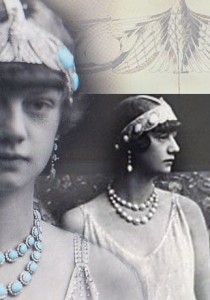
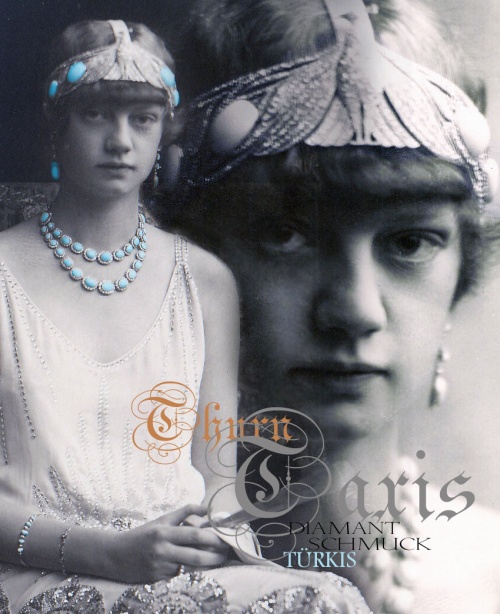
Smaragd Brosche | Schmuck Thurn und Taxis| The emerald brooch made by Hancocks
Das kleine Diamant
Diadem in Schleifenform | Princess Maria Josephas Tiara
Das Rubin Cabochon
Diamant Halsband im Stil der 40er Jahre von Fürstin
Gloria | Rubies
Die Diamant
Brosche der Kaiserin Marie Louise von Frankreich | Empress
Marie Louises stomacher
Das Köchert Fuchsien
Diadem | The Diamond Fuchsia Tiara made by Koechert
Das grosse Diamant Empire
Diadem der Fürstin Margarethe | Large Diamond Empire
Tiara
Die Rubin
– Ohrringe aus dem Haus Orleans | Princess Thurn and Taxis
Rubies
Fürstin
Margarethe:Diamant Diadem mit Smaragdtropfen |Hancocks Emerald
and Diamond Tiara
Fürstin Gloria:Diamant
Diadem mit Smaragdtropfen | Hancocks Emerald and Diamond Tiara
Bericht über die grosse fürstliche
Juwelen-Auktion | The auction of the princely Jewels
Empire Style Diamant Saphir Diadem | Sapphire Diamond Tiara of the Princes of Thurn and Taxis
Übersicht Thurn und Taxis | The Collection
of Thurn and Taxis
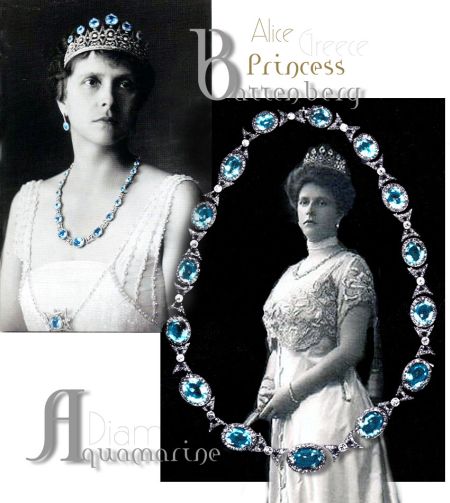
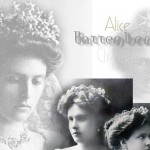
Dem „Temps“ wird aus Petersburg über die Reisepläne des Kaisers Nikolaus berichtet:
Am 14. oder 15. September 1903 gedenkt der Zar, der gegenwärtig jagt, nach Darmstadt zu dem gewohnten Aufenthalte bei den Verwandten der Kaiserin zu fahren.
Diesmal gibt es für seine Anwesenheit in Darmstadt noch einen besonderen
Grund: Die bevorstehende Vermählung des Prinzen Andreas von Griechenland, des jüngsten Sohnes des Königs Georg, mit einer Prinzessin von Battenberg. Gegen Ende des Monats, wahrscheinlich am 24., begiebt der Zar sich in die Steiermark, um mit dem Kaiser von Oesterreich zu jagen.
Doch begleitet Graf Lemsdorff seinen Gebieter dorthin, woraus man schliessen darf, dass die beiden Kaiser sich nicht blos dem Jagdvergnügen widmen, sondern sich ernstlich mit den orientalischen Angelegenheiten beschäftigen werden.
Nach dem Aufenthalt in Oesterreich wird der Zar nach Darmstadt zurückkehren und bis Ende October, 1903 bis zur Reise nach Italien (-wurde später abgesagt-), dort bleiben.
Während der Anwesenheit des Zarenpaares findet die Einweihung
der auf der Mathildenhöhe erbauten Russischen Kapelle statt, in welcher am 7. October Prinz Andreas von Griechenland und die Prinzessin Alice von Battenberg den Bund für das Leben schließen werden. Die Trauung
findet, wie wir bereits meldeten, auch nach protestantischen Ritus statt.
Princess Alice of Battenberg | Jewels | Princess Andrew of Greece
The Battenberg / Mountbatten Stars Tiara and wedding jewelry | Bandeau
Schmuck und Juwelen der Prinzessin Alice von Battenberg | Bandeau
Prinzessing Alice von Battenberg als Braut mit dem Mountbatten-Battenberg Sterne Diadem
Ein sehr grosszügiges Geschenk brachte der Zar zur Hochzeit mit.
Prinzessin Alice erhielt ein wahrlich imperiales Hochzeitsgeschenk von Ihrer Tante Alexandra, der Schwester Ihrer Mutter Victoria – der Tsarin von Russland und deren Mann, dem Zar. Die Historie und weitere Details zum Brautgeschenk ausführlich in deutsch:
Related websites:
Wedding Victoria of Hesse | gifts and presents | Hochzeit Milford-Haven
Tiara Victoria of Hesse | Hochzeitsgeschenke| Battenberg Milford-Haven
The Mountbatten Jewels | Mountbatten Schmuck >>
Pearls Battenberg Mountbatten Jewels | Mountbatten Perlen Schmuck >>
Art Deco-Diamond Necklace-Bracelets | Art Deko Diamant Halsband >>
Emerald – Brillant Diamond Necklace | Smaragd Brillant Diamant Halsband >>
Art-deco Emerald – Brillant Diamond Necklace | Artdeko Smaragd Brillant Diamant Halsband >>
The Diamond Tiara | Mountbatten Diadem>>
The Viceroy and the Viceraine at the coronation | Anlässlich der Krönung>>
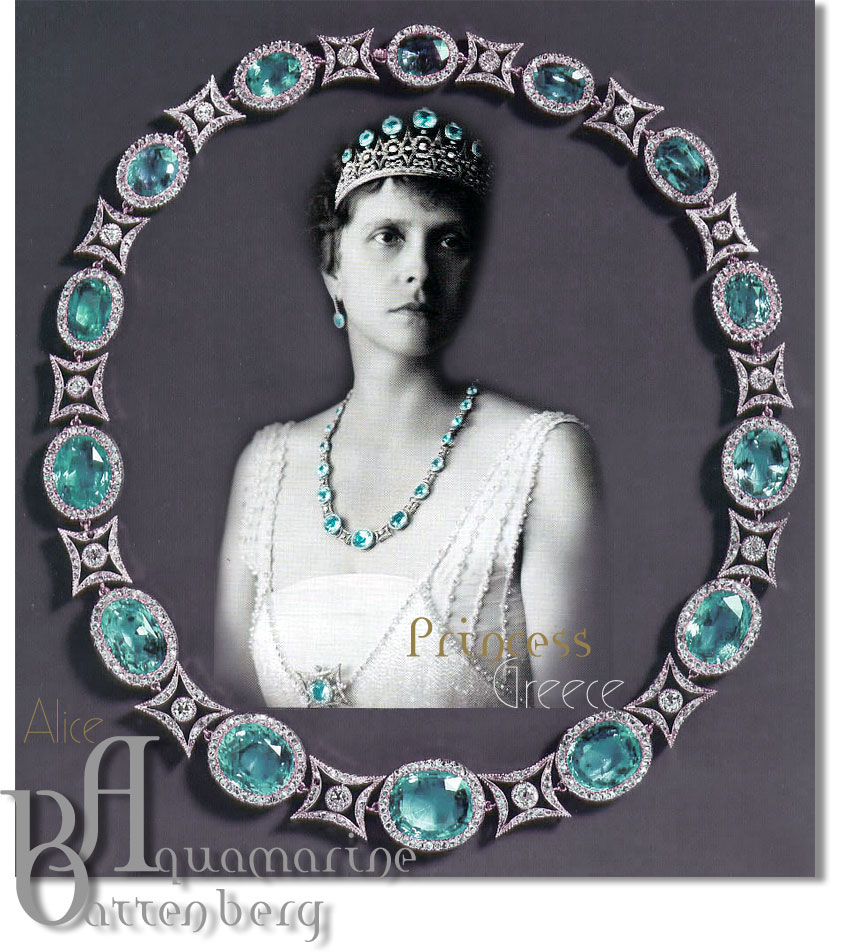
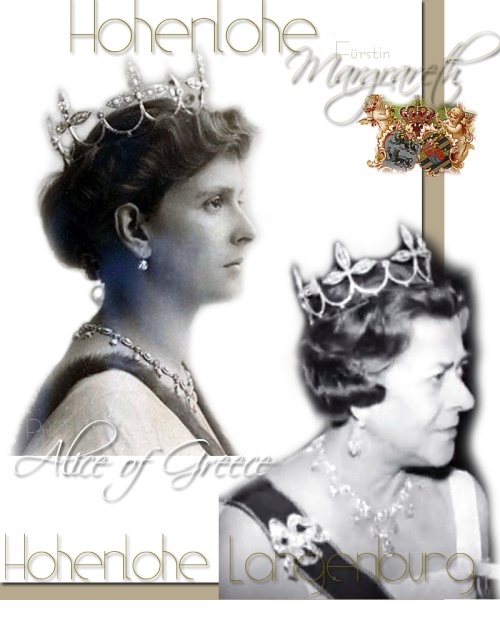
Grand Duchess Elizabeth Fyodorovna Emeralds
well the video is now uploaded again on youtube
…the history of this Romanov Jewels was published in 2010 with detail of the tiara, worne from Grand Duchess Ella on the occasion of the wedding in 1894 at Coburg, you will find some of the pictures also – as well as the large one of the tiara I had made from all sides
http://www.royal-magazin.de/russia/ella/ella-bolin-emerald-tiara.htm
http://www.royal-magazin.de/russia/ella/maria-pavlovna-sweden-ella.htm
http://www.royal-magazin.de/russia/ella/ella-smaragd-kokoshnik.htm
http://www.royal-magazin.de/russia/ella/ella-emeralds-queen-yugosl.htm
http://www.royal-magazin.de/russia/ella/ella-emeralds-queen-mignon.htm
http://www.royal-magazin.de/russia/ella/ella-emeralds-stomacher.htm

Aquamarine Parure Romanov Aquamarines Grand Duchess Elisabeth Feodorowna – Elizabeth Fyodorovna

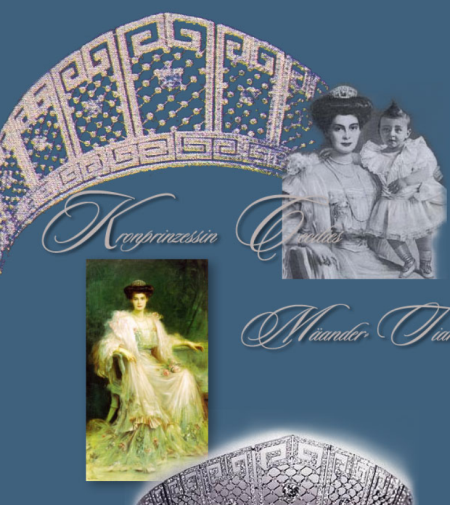
Princess Kira, Xenia, Marie-Cecile…Brides of the House Prussia
